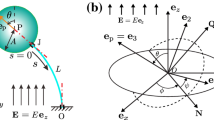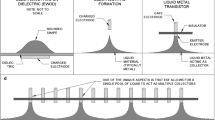Abstract
Curved electrode electrostatic actuators have been shown to have the potential to manipulate microparticles at high speeds in viscous dielectric media. However, there are no multiphysics models that fully describe the mechanics of these actuators in viscous dielectric media. This work is the first step in the direction of describing the actuator mechanics through Finite Element Method (FEM) simulations and validate it with the experiments. Simulations are performed using the commercial software Coventor MEMS+® and the results are found to be in good agreement with experiments. Two observations are reported in this study. One, for a given media and low actuator displacements, the cutoff frequency of the actuator is independent of the actuation voltage and/or actuator displacement. Two, an actuator immersed in a high viscous media will have higher squeeze film damping and a lower cutoff frequency. Through a simple lumped-parameter model of the actuator, we report that the viscous damping effect by the substrate on the actuator submerged in methanol or water media becomes significant for actuation frequencies >100 Hz.








Similar content being viewed by others
References
Yang S, Xu Q (2017) . Journal of Micro-Bio Robotics 13(1):1. https://doi.org/10.1007/s12213-017-0098-2
Warnat S, King H, Forbrigger C, Hubbard T (2015) . J Micromech Microeng 25(2):025011. http://stacks.iop.org/0960-1317/25/i = 2/a = 025011
Shen ZL, Dodge MR, Kahn H, Ballarini R, Eppell SJ (2008) . Biophys J 95(8):3956. https://doi.org/10.1529/biophysj.107.124602. http://www.sciencedirect.com/science/article/pii/S0006349508785345
Desmaële D, Boukallel M, Régnier S (2011) . J Biomech 44 (8):1433. https://doi.org/10.1016/j.jbiomech.2011.02.085. http://www.sciencedirect.com/science/article/pii/S0021929011001771
Scuor N, Gallina P, Panchawagh HV, Mahajan RL, Sbaizero O, Sergo V (2006) . Biomed Microdevices 8(3):239. https://doi.org/10.1007/s10544-006-8268-3
Bell DJ, Lu TJ, Fleck NA, Spearing SM (2005) . J Micromech Microeng 15(7):S153. http://stacks.iop.org/0960-1317/15/i=7/a=022
Senturia SD (2001) Microsystem Design. Springer, USA
Burugupally SP, Mangels JA (2018) . Microsyst Technol 24(8):3479. https://doi.org/10.1007/s00542-018-3751-3
Burugupally SP, Hoelzle D (2018) . Appl Phys Lett 113(7):074102. https://doi.org/10.1063/1.5042456
Hoelzle DJ, Chan CK, Scott MB, Lake MA, Rowat AC (2015) . J Appl Phys 117(1):014503. https://doi.org/10.1063/1.4905385
Hopcroft MA, Nix WD, Kenny TW (2010) What is the Young’s modulus of silicon?. J Microelectromech Syst 19(2):229–238. https://doi.org/10.1109/JMEMS.2009.2039697
Williams KR, Gupta K, Wasilik M (2003) . J Microelectromech Syst 12(6):761. https://doi.org/10.1109/JMEMS.2003.820936
Mukundan V, Pruitt BL (2009) . J Microelectromech Syst 18(2):405. https://doi.org/10.1109/JMEMS.2009.2013398
Burugupally SP (2018) Curved electrode electrostatic actuator simulation in DI water and methanol media. https://doi.org/10.5281/zenodo.1482724
Meirovitch L (2001) Fundamentals of Vibrations. mcgraw-Hill higher education. McGraw-Hill, New York City
Rollier A, Faucher M, Legrand B, Collard D, Buchaillot L (2007) arXiv:abs/0711.3321
Shih RM, Contreras DS, Massey TL, Greenspun JT, Pister KSJ (2018) In: 2018 IEEE Micro Electro Mechanical Systems (MEMS), pp 596–599. https://doi.org/10.1109/MEMSYS.2018.8346624
Preetham BS, Lake MA, Hoelzle DJ (2017) Napa Microsystems Workshop 2017
Acknowledgements
The author would like to thank David Hoelzle at The Ohio State University for granting access to research facilities to conduct experiments shown in this work. Also, the author would like to that Coventor MEMS+® for providing the software application. This work was supported in part by University of Notre Dame Walther Cancer Foundation IITP Fellowship, University Research/Creative Projects award at Wichita State, and Wichita State and Notre Dame capitalization funds. Technical consultation was given by the Notre Dame Nanofabrication Facility.
Author information
Authors and Affiliations
Corresponding author
Additional information
Publisher’s Note
Springer Nature remains neutral with regard to jurisdictional claims in published maps and institutional affiliations.
Appendix
Appendix
Actuator Fabrication Recipe On the SOG wafer, a composite metal film comprising of 30 nm Cr and 200 nm Au is deposited on the silicon side by e-beam evaporation and patterned by photolithography to make electrical contact pads (a, b). Next, an etch mask to be used for bulk micromachining of actuator components is defined by depositing a 1000 nm thick SiO2 layer using a plasma enhanced chemical vapor deposition (PECVD) process (processed at 250 °C using SiH4/N2O gases), patterned using a photoresist mask, and then etched using inductively coupled plasma assisted reactive ion etching process (RIE-ICP; using CHF3/Ar gases) (c, d). The high-aspect ratio actuator features (curved electrodes, beam electrode, reinforcing beam) are machined by DRIE using a standard Bosch process in 5s:2s step cycles; the glass substrate acts as an etch stop (e). After DRIE, the movable structures of the actuator are released by timed HF (49% HF:H2O::1:1 volume ratio) wet etch process for approximately 2 minutes at standard room temperature, triple rinsed in water, then in methanol, and then dried at room temperature (f). Next, the actuator is coated with 10 nm thick Al2O3 insulator film using atomic layer deposition (ALD) process (processed at 120 °C using TMA/O2 precursors) (g). Finally, the 10 nm thick Al2O3 insulator film is anisotropically etched using inductively coupled plasma assisted reactive ion etching process (RIE-ICP; using BCl3/Cl2 gases) to unmask the Au/Cr electrical contact pads that were coated with Al2O3 during the ALD process (h) (Figs. 9 and 10).
Fabrication scheme of the actuator. [Figure adapted from Ref. [8] with permission from Springer Nature Microsyst. Technol. 24, 3479 (2018). Copyright 2018 Springer-Verlag GmbH Germany, part of Springer Nature]
A convergence plot for the nonzipped operating mode of the actuator for \(\bar V\)= 4 V in deionized water media. The convergence test shows that convergence begin to occur for Bernoulli beam elements ≥ 120; hence 120 beam elements are chosen for constructing the 3-dimensional FEM model of the actuator
Rights and permissions
About this article
Cite this article
Burugupally, S.P. Mechanics of a curved electrode actuator operating in viscous dielectric media: simulation and experiment. J Micro-Bio Robot 15, 43–51 (2019). https://doi.org/10.1007/s12213-019-00114-2
Received:
Accepted:
Published:
Issue Date:
DOI: https://doi.org/10.1007/s12213-019-00114-2






